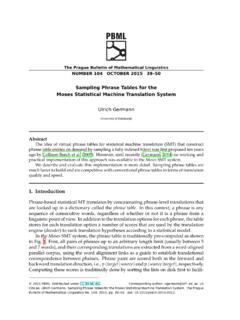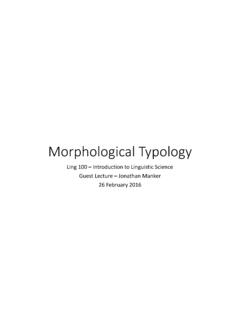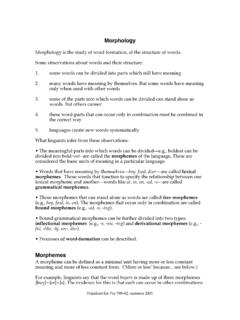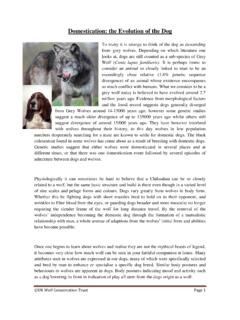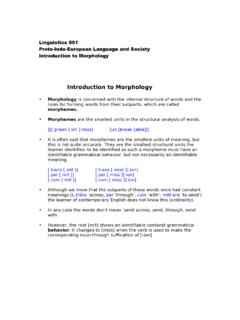Transcription of Intro to Linguistics { Basic Concepts of Linguistics
1 Intro to Linguistics Basic Concepts of LinguisticsJirka Hana October 2, 2011 Overview of topics Language and Languages Speech vs. Writing Approaches to language: Descriptive vs. Prescriptive Grammar and its parts Arbitrariness (conventionality)1 LanguageLanguageis a system that associates sounds (or gestures) with meanings in a way that useswords and the scientific study of human language. It tries: first, to observe languages and to describe them accurately, then, to find generalizations within what has been described, finally, to draw conclusions about the general nature of human linguisticsattempts to make practical use of the knowledge derived from generallinguistic research in order, for example, to: improve the ways in which a student s native language is taught help people learn foreign language more efficiently write better dictionaries improve therapy for people with language problems search the Internet more efficiently and successfullyLinguistics overlaps and (ideally) cooperates with: psychology, sociology, anthropology, phi-losophy, logic, mathematics, computer science, speech pathology, acoustics, music, crypt-analysis, Speech vs.
2 Why it is sometimes claimed that writing is primary Written texts tend to be more carefully worded and better organized than spoken texts,they contain fewer errors, hesitations, and incomplete sentences, because writing isusually planned in advance, is subject to fewer time constraints, is proofread, : How about instant messaging, quick e-mails? Spelling is more uniform across different individuals, places and times using the samelanguage than is :Swau l asku slawjk r u zi p el R u zinu gewil wonn y wzdech. Gezero hladk e wk rowjch stinn ych[ acha: M ag 1836]However: UK:tyre,draught,colour,dialogue,penalise ,centre,defence, ..USA:tire,draft,color,dialog,penalize,c enter,defense, ..Moreover: Is uniformity the same as primacy? Written texts last and can be preserved for a long : CDs, youtube .. can preserve speech Writing styles change much more slowly than speech styles, and so writing seems more permanent and authoritative.
3 However: This can be is also disadvantage writing lags behind the Linguists reasons for claiming that speech is primary Historically, spoken language existed much earlier than was most likely invented in Sumer (Mesopotamia, current Iraq) about 5500years ago. Language probably exists for 40,000 or more. There are many societies which only speak their language and do not write it. And nosociety uses only a written language (with no spoken form). We learn to speak before we learn to write. Most people say more during one month than they write during their entire lives. Writing must be taught, whereas spoken language is acquired automatically. Psycholinguistic evidence suggest that the processing and production of written lan-guage is overlaid on the spoken language centers in the brain (plus certain other cen-ters). Speech contains information that writing lacks intonation, stress, voice quality ..23 Descriptive vs. Prescriptive Approach to Descriptive Approach Linguists attempt todescribethe grammar of the language that exists in the minds ofits speakers, to create a model of speakers mental grammar.
4 The resulting descriptive grammar describes person s Basic linguistic knowledge. Itexplains how it is possible to speak and understand and it summarize what speakersknow about the sounds, words, phrases and sentences of their language. Creating a descriptive grammar involves observing the language and trying todiscoverthe principles or rules that govern it. Descriptive rules accept as given the patterns speakers actually use and try to accountfor them. Descriptive rules allow for different dialects of a language and even variationwithin one Prescriptive Approach Prescriptivists tell you someone s idea of what is good or bad . Prescriptive rules make a value judgment about the correctness of certain utterancesand generally try to enforce a single standard. For example:English: Don t split infinitives; don t say:to easily understand Don t end a sentence with a preposition; don t sayWhere are you from?Czech: Proto je t reba jednozna cn e odm tnout a do slu sn e spole cnosti nepou st et p redev s mhr uzy typu chromoz om ci l yzoz om, nebo t ty mohou u z vat pouze m alo gramotn eosoby neznal e z akladu s oma-s omatos.
5 Stejn e odpudiv a a nep rijateln a je alenap r. i Ho rej s : Pl a c jazyka cesk eho. 1 Feb 2010 Don t usemisti cka, use the correctmi sti cka[1930 s] The people who prescriptive grammarmake upthe rules of the grammar. They attempt to impose the rules for speaking and writing on people without muchregard for what the majority of educated speakers of a language actually say and write. So-called prescriptive grammar usually focuses only on a few issues and leaves the restof a language undescribed (unprescribed?). In fact, from the linguistic point of view,this is not grammar at Prescriptivism vs. DescriptivismIn summary: Linguistsdescribelanguage, they do a science, Linguistics : is not in the business of making value judgments about language use. studies how language really is used and then attempts todescribethe facts, in orderto analyze and, eventually, explain Analogy: Physicists: don t complain that objects fall to earth simply observe and describe the fact of falling, then try to discover the laws thatare behind it.
6 Linguists: don t say that people shouldn t useain torbysme colloq. would1pl simply observe that some people in certain situations do useain t(without judg-ing, although they do note any systematic correlations of such use with particulargroups, regions, situations, styles, etc.)4 The parts of GrammarGrammaris a language system, a set of principles (rules) that underlie a Grammar the knowledge of language that allows a person to produce and un-derstand utterancesGrammar can be described as having different parts: phonetics phonology morphology syntax semantics pragmaticsSince linguists study all of these, the terms are also used to refer to subfields of Phonetics & PhonologyPhonetics the production and perception of speech sounds as physical , [v] is pronounced by bringing the lower lip into contact with upper teeth and forcingair out of the mouth while the vocal folds vibrate and nasal cavity is closed the sound patterns (the sound system of a particular language) and of soundsas abstract Czech, a word never ends with a voiced obstruent ( ,zubu[zubu] toothgen butzub[zup] toothnom ).
7 In English, a word never starts with [kn] (note thatknifestarts with [n] not [k]), while inGerman it is possible ( ,Knabe boy )In Setswana (a language of southern Africa), a consonant is always followed by a vowel when the speakers adopted the wordChristmasfrom English, they pronounce MorphologyMorphology the word structure and of systematic relations between the building-blocks of words, the smallest linguistic unit which has a meaningor grammatical are composed of morphemes (one or more).Sing-er-s answer-ed un-kind-lyu c-i-tel-k-u she-teacheracc In comparison with many other languages, English has rather simple SyntaxSyntax phrase and sentence structureSyntacticians try to discover rules that govern:word order:The book is on the table.*Table book on is the :I am here.*I are forms (cases):I like her.*I like : In Linguistics , placing an asterisk (*) before a sentence marks that sentence as ungrammatical, , not of the kind normally used by most speakers of that SemanticsSemanticsis the literal meaning of sentences, phrases, words and , What is the meaning of the wordvegetable?
8 , How does the word order influence meaning of sentence in English? How about Czech? PragmaticsPragmaticsstudies language usage, especially how context influences the interpretation ofutterances the same sentence can be used to do different things in different ,Gee, it s hot in here!can be used either to state a fact or to get someone open put: semantics is the literal meaning and pragmatics is the intended ArbitrarnessThe relation between form and meaning in language can be either: arbitrary(conventional), in which case: the meaning is not deducible from the form the form is not deducible from the meaning the connection between the form and meaning must be learned via memorization nonarbitrary the meaning is (at least partly) derivable from the form, and vice ,buzzEn,bzu cen Cz sound of the type made by (the wings of) bees iconicity the most extreme example of nonarbitrary form/meaning connection: theform shows a physical correspondence to the meaning and vice versaNon-language examples: arbitrary: traffic lights, warning siren nonarbitrary.
9 A no-smoking sign (with a crossed-out cigarette), a deer-crossing sign(with a silhouette of a deer)Language is overwhelmingly language were not arbitrary, then: different languages would not use different words for the same thing (in fact, therewould be just one language), as they obviously do:Englishtree, Czechstrom, Frencharbre, GermanBaum, Japaneseki, Koreannamu. word forms would not change over English (before 1100)h us Modern Englishhouse word meanings would not change over timeMiddle English (before 1500)girle child Modern Englishgirl girl Middle Englishnice ignorant Modern Englishnice pleasant Old Czechletadlo bird Modern Czechletadlo airplane Limited Exceptions: Onomatopoeia and Sound SymbolismThere are two very limited and partial exceptions to the arbitrariness of language: Onomatopoeia= words whose sound imitates either the sound they denote or asound associated with something they denote.
10 These words are not entirely , different languages represent the same natural sounds in slightly differentways ( , . Englishcock-a-doodle-doo6= Czechkykyryk y), which shows that they arenot completely nonarbitrary, Sound symbolismrefers to the very vague, elusive way in which certain sounds feel more appropriate for describing certain objects or meanings than do other sounds. the vowels [i] or [I] seem to suggest smallnessteensy-weensy,wee,little,Tommy( ),squeak;but:big to English speakers,gl-suggest brightness:glint glitter, gleam, glow;but:glove, glue, glum, Why is arbitrariness is an advantage? It allows user of a communication system to adopt the most convenient means availablefor communicating, since it obviates any need for the forms of signs to bear an inherentrelationship to their meanings. It also makes it much easier for users of a communication system to refer to abstractentities, since it is hard to find a combination that involves an inherent link between aform and an abstract
